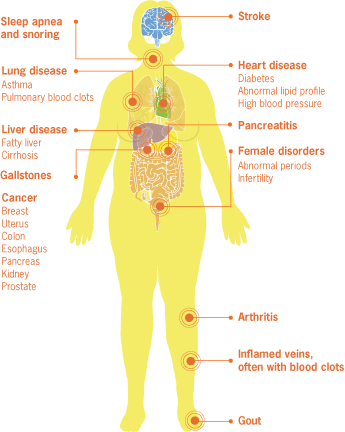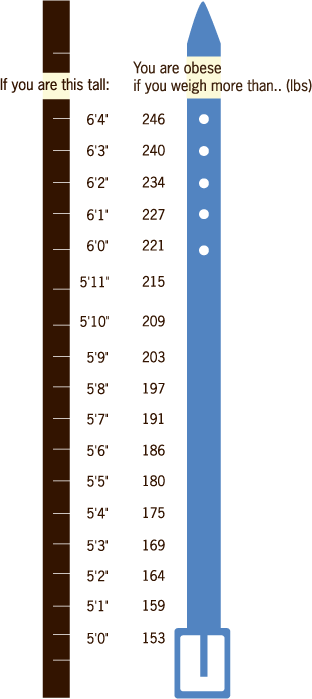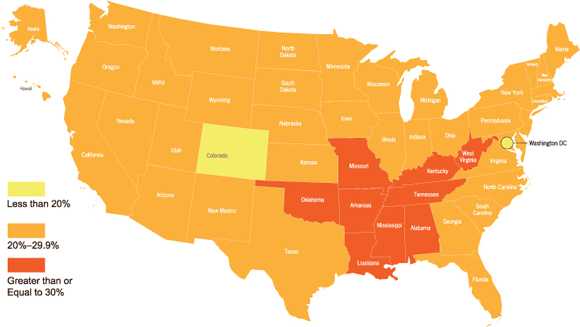Adult Obesity
Obesity Rises Among Adults
August 2010


 72M+
72M+
More than 72 million U.S. adults are obese.
 1,429
1,429
Persons who are obese have medical costs that are $1,429 higher than those of normal weight.
 Zero
Zero
No state has an obesity rate less than 15%, the national goal.
Obesity is common, serious, and costly. In 2009, about 2.4 million more adults were obese than in 2007. This epidemic has affected every part of the United States. In every state, more than 15% of adults are obese, and in nine states, over 30% of adults are obese. The medical care costs of obesity in the United States are staggering. In 2008 dollars, these costs totaled about $147 billion. More efforts are needed, and new federal initiatives are helping to change our communities into places that strongly support healthy eating and active living.
Problem
Adult Obesity
Obesity is a national epidemic, causing higher medical costs and a lower quality of life.
- Obesity means having excess body fat. Obesity is defined by body mass index, or BMI, which is calculated from your height and weight.
- BMI greater than or equal to 30 means you are obese.
- Non-Hispanic black women and Hispanics have the highest rates of obesity (41.9% and 30.7%).
- Obesity is a contributing cause of many other health problems, including heart disease, stroke, diabetes, and some types of cancer. These are some of the leading causes of death in the U.S. Obesity can cause sleep apnea and breathing problems and make activity more difficult. Obesity can also cause problems during pregnancy or make it more difficult for a woman to become pregnant.
- Obese persons require more costly medical care. This places a huge financial burden on our medical care system.
Why is this epidemic happening?
- Weight gain occurs when people eat too much food and get too little physical activity.
- Societal and community changes have accompanied the rise in obesity.
- People eat differently:
- Some Americans have less access to stores and markets that provide healthy, affordable food such as fruits and vegetables, especially in rural, minority and lower-income neighborhoods. Restaurants, snack shops, and vending machines provide food that is often higher in calories and fat than food made at home.
- There is too much sugar in our diet. Six out of 10 adults drink at least 1 sugary drink per day.
- It is often easier and cheaper to get less healthy foods and beverages.
- Foods high in sugar, fat, and salt are highly advertised and marketed.
- Many communities are built in ways that make it difficult or unsafe to be physically active:
- Access to parks and recreation centers may be difficult or lacking and public transportation may not available.
- Safe routes for walking or biking to school, work, or play may not exist.
- Too few students get quality, daily physical education in school.
Medical Complications of Obesity

Source: Adapted from Yale University Rudd Center for Food Policy and Obesity
Obesity Table

Source: National Heart, Lung, and Blood Institute Table Calculate Your Body Mass Index Web Site.
U.S. State Info
The number of people who are obese varies from state to state. For example, 18.6% of Colorado residents are obese, compared with 34.4% of Mississippi residents. In 2009, 9 states had obesity rates of 30% or more compared with no states in 2000.
Prevalence of obesity among adults — Behavioral Risk Factor Surveillance System, United States, 2009

What Can Be Done
The U.S. Government can
- Promote change
- First Lady Michelle Obama recently launched the Let's Move! program which seeks to eliminate childhood obesity within a generation.
The campaign's main points of action are:- Empowering parents and caregivers.
- Providing healthy food in schools.
- Improving access to healthy, affordable foods.
- Increasing physical activity.
- First Lady Michelle Obama recently launched the Let's Move! program which seeks to eliminate childhood obesity within a generation.
- Recommend actions
- In May 2010, The Childhood Obesity Task Force, appointed by President Obama, released 70 recommended actions to prevent and control childhood obesity.
- A new CDC program, Communities Putting Prevention to Work,* is designed to improve nutrition and physical activity and prevent and control obesity by changing policies and environments. CDC recently provided $139 million to 50 states and $373 million to 30 communities and tribes to fund programs to reverse the obesity epidemic.
*Communities Putting Prevention to Work is a new program included in the American Recovery and Reinvestment Act of 2009. It also addresses decreasing tobacco use.
States can
- Provide supermarkets and farmers' markets with incentives to establish their businesses in low-income areas and to offer healthy foods.
- Expand programs that bring local fruits and vegetables to schools, businesses, and communities.
- Support hospital programs that encourage breastfeeding.
- Adopt policies that promote bicycling and public transportation.
Communities can
- Create and maintain safe neighborhoods for physical activity and improve access to parks and playgrounds.
- Advocate for quality physical education in schools and childcare facilities.
- Encourage breastfeeding through peer-to- peer support programs.
- Support programs that bring local fruits and vegetables to schools, businesses, and communities.
All people can
- Eat more fruits and vegetables and fewer foods high in fat and sugar.
- Drink more water instead of sugary drinks.
- Limit TV watching in kids to less than 2 hours a day and don't put one in their room at all.
- Support breastfeeding.
- Promote policies and programs at school, at work, and in the community that make the healthy choice the easy choice.
- Try going for a 10-minute brisk walk, 3 times a day, 5 days a week.
Science Behind the Issue
Related Pages
- Obesity
- Morbidity and Mortality Weekly Report (MMWR): Obesity
- Download Vital Signs [PDF - 1.99 MB]
- Podcast: The Obesity Epidemic - What Can Be Done?
- Podcast: Obesity and Women
- PSA: The Obesity Epidemic - What Can Be Done?
- The Community Guide: Obesity
- Obesity - What You Need to Know [PSA - 0:60 seconds]
- Obesity [PODCAST - 0:60 seconds]
- Page last reviewed: August 3, 2010
- Page last updated: August 3, 2010
- Content source:
Error processing SSI file


 ShareCompartir
ShareCompartir